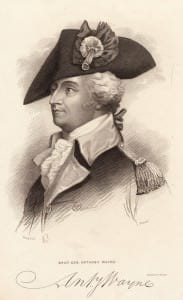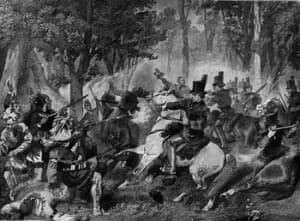Indiana Becomes a State
After George Rogers Clark and his army captured the lands west of the Appalachian Mountains, the Governor of Virginia, Patrick Henry, gave Clark and his men land in what is now Indiana. This land was settled by Clark and his men and they built a small town they called Clarksville, the first American settlement in Indiana. Jeffersonville and New Albany, Indiana were also founded around this same time.
At this time, the land that would later become the state of Indiana was located in a region referred to as the Northwest Territory, which was enacted by the United States government in 1787. The new federal government of the United States wanted to make sure this new land in the Northwest Territory was sold and settled in a peaceful and legal manner. New laws (called ordinances) were passed to make this process of settling easier and lawful. The Ordinance of 1785 specified how new land was to be surveyed, divided and sold. The new land would be divided into townships 6 miles square. To read a copy of the Northwest Ordinance that set up the Northwest Territory click here
Each township would then be divided into 36 equal sections. Each section would be 640 acres in size. The sections would then be numbered from 1 to 36. The Ordinance of 1785 also had a stipulation that in every township, section number 16 was to be set apart for the use of a public school. The remaining sections of a township were then to be sold. This method of land surveying and township numbering is still in use today.
The Northwest Ordinance also told how parts of the Northwest Territory could become states. It was specified that an area of land had to have 60,000 people in order to petition the federal government for statehood. The Northwest Ordinance also stated that no one living in the Northwest Territory could own or keep slaves. The building of public schools was also a part of the ordinance. The rights of freedom of speech and religion given to states within the United States would also extend to the Northwest Territory.
Indian Conflicts
Even though laws and regulations were passed to regulate land ownership within the Northwest Territory, a major problem still existed. The Indians now claimed that the land was theirs. Tribes in the Ohio Valley started to attack settlers who moved into the Ohio Valley and the Northwest Territory.
The English after the American Revolution, some of whom had stayed in forts around the Great Lakes to protect their fur trading interest, encouraged the Indian tribes in the Northwest Territory to form a confederation to drive out the new American settlers. The Delaware, Shawnee, Miami and Potawatomi joined together in this new confederation. Their leader was the Miami chief Little Turtle.

President George Washington was upset at St. Clair’s defeat and assigned one of his best generals to lead the fight against the Indians. Washington appointed General “Mad Anthony” Wayne. He was nicknamed “Mad” because he was a fierce fighting soldier.
Wayne set out for the Northwest Territory in 1793. Washington had given him an army of about 1,000 soldiers. “Mad Anthony” Wayne traveled through the western part of Ohio where he established a fort at what is now Greenville, Ohio. He then spent the entire winter drilling and preparing his army for battle. Meanwhile, the English built a new fort at Toledo, Ohio and named it Fort Miami, after a previous fort.
Little Turtle spied on “Mad Anthony” Wayne’s activities at Fort Greenville. He gathered chiefs from the other tribes within the confederation and encouraged them to make peace. However, the other chiefs were excited that the English had built the new Fort Miami and assumed they would help the Indians defeat Wayne’s army.
Battle of Fallen Timbers

The Indians had decided to engage Wayne’s army at a place called Fallen Timbers. Fallen Timbers was a place in the forest that had experienced a recent tornado that had knocked down many large trees. The Indians concluded that this would be a very difficult place for a disciplined army to fight in an orderly way.
General Wayne let it be publicly known that he intended to attack the Fallen Timbers area on August 17th. When the day came, he waited. General Wayne knew that most Indians did not eat on the day before a battle. He continued waiting for three days. By that time, at least, 500 Indian warriors had left Fallen Timbers to look for food. Those that remained were weakened by the lack of food. General Wayne then led his attack against the remaining Indians at Fallen Timbers. In two hours the battle was over.
The retreating Indians ran to Fort Miami seeking protection and shelter. However, the English refused to let them in fearing a war with the Americans. General Wayne then sent his army marching up the Maumee River destroying Indian corn fields and villages as they went. At the Maumee portage, where the French had once built a fort, Wayne’s army built Fort Wayne.
The Battle of Fallen Timbers forever crushed the Indian confederation. Little Turtle and the other chiefs of the confederation signed the Treaty of Greenville. After signing the treaty, Little Turtle was recorded as saying, “I have been the last to sign it and I will be the last to break it.” The treaty allowed Americans to settle peacefully into what is now Ohio and southeastern Indiana. The treaty brought peace to the Northwest Territory for 15 years.
To read the Treaty of Greenville click here
Indiana as a Territory
By the year 1800 there were enough settlers in the Indiana Territory to hold an election. William Henry Harrison, a former Indian fighter and, later, the ninth president, was appointed congressman. He went to Congress pushing the policy that the Indiana Territory needed new laws. A major concern for Harrison was that it was expensive to buy land in the territory. Congress agreed and lowered the price of land within the Indiana Territory.
One section of the new price lowering law said that settlers could buy land on credit. They could live on the land and pay for it later. This law started a mass migration to the Indiana Territory. Congress also divided the territory into two parts. One part became the Ohio Territory and the other became the Indiana Territory. The Indiana Territory stretched from Indiana’s present eastern border to the Mississippi River.
President John Adams named William Henry Harrison as the first governor of the Indiana Territory. The old French city of Vincennes became the territory’s capital. Harrison built a very large, finely decorated house and called it Grouseland. You can visit Grouseland by clicking here
Once again, the Indiana Territory was divided. In 1809 the western part of the Indiana Territory became the Illinois Territory with the same borders the modern state of Illinois has today.
Most settlers living in the Indiana Territory lived close to the Ohio River in the southern part of the territory. The remainder of the Indiana Territory belonged to the Indians. Harrison took charge at buying the remaining land from the Indians. He made many treaties with the Indians who agreed to sell their lands to him. The Indians rarely saw any money for the land they sold. By the end of 1806 the Indians had sold all their land in the southern part of the Indiana Territory.
Tecumseh and His Brother "The Prophet"
Many Indians in the Indiana Territory were upset that the land promised them was now being sold on false promises. The leader of the Shawnee, Tecumseh, had been a part of the Miami confederation and fought at the Battle of Fallen Timbers. He dreamed of a separate state for the Indians, an idea the English had supported.
Tecumseh traveled from tribe to tribe, village to village lecturing about this separate Indian land. He encouraged tribes from fighting among each other and unite to fight against the encroaching American settlers.
Tecumseh’s brother was a Shawnee medicine man named the Prophet. As a medicine man he knew the prayers and customs of the Shawnee religion. The Shawnee had great respect for him.
One incident that occurred in the Prophet’s life that made the Shawnee people believe in his power happened one summer. The Prophet made an announcement to the Shawnee people that he would make the sun stop in the sky. Unknown to anyone, the Prophet had talked to a Canadian trader who told him when an eclipse was going to occur. When the eclipse happened on the day the Prophet had said, the Shawnee believed he had done it and believed he possessed powerful magic.
The Prophet lived in a place called Prophetstown that is located on the Tippecanoe River where Lafayette is today.
In the Treaty of Fort Wayne, that was signed in 1809, a group of Indian tribes agreed to sell 3 million acres of land in the Indiana Territory. Tecumseh visited Governor Harrison on this matter. The land was the common property of many different tribes of Indians, Tecumseh said. He went on to inform Governor Harrison that the tribes that signed the treaty had no rights to sell that land, it did not belong exclusively to them. Tecumseh made it known to the governor that the Indians would fight if any more of their land was taken. Tecumseh’s warriors were eager to fight. The Prophet made the announcements that through his magic he would make the Indian warriors invincible to the white man’s bullets.
Tecumseh left Prophetstown in 1811 to speak with Indian tribes south of the Ohio River. Before he left he told his brother the Prophet to keep the peace until he returned.
William Henry Harrison decided to attack Prophetstown while Tecumseh was gone. Harrison’s 1,000 soldiers traveled from Vincennes north along the Wabash River towards Prophetstown. When they reached the outskirts of Prophetstown they pitched camp overnight. At dawn on November 7, 1811 the Prophet, leading a group of Indian warriors, attacked Harrison’s army. The army fought back and forced the Indian warriors to retreat. This battle has become known as the Battle of Tippecanoe. Neither side won a true victory. Harrison and his militia burned Prophetstown to the ground while some Indian warriors spread out through the Indiana Territory attacking settlers. A majority of Indians left with Tecumseh to settle in Canada.
You can visit Battle Ground, Indiana and learn more about the Battle of Tippecanoe by clicking here
The War of 1812
In America’s view, the English were to blame for the Indian attacks on American settlers. They believed England was providing guns, supplies and encouragement to the Indian tribes. Settlers in the Ohio Valley thought the solution was simple: attack Canada and drive the English out. At the settlers request, the United States declared war on England (again) in 1812. This became known as the War of 1812.
William Henry Harrison gave up his position as governor to lead the American military force against Canada and the English. However, the Americans found it very difficult to war against Canada. Most of the time the army was forced to defend itself against attacks. From their fort in Detroit, the English sent out troops to attack American settlements, including Fort Wayne. Indian warriors, led by Tecumseh, once again fought against the settlers on the side of the English.
However, an American commander named Oliver Hazard Perry led and attack against the English on Lake Erie in 1813. The defeat of the English by Perry’s army led to a turning point in the war. Perry’s victory weakened English control of the Great Lakes. This defeat made it possible for Americans to cross Lake Erie by boat. William Henry Harrison led his army across Lake Erie to attack the English at Detroit.
When Harrison’s army arrived at Detroit the English were gone. The American army discovered the English were headed northeast on the Thames River. Harrison and his 3,000 men followed. A week later Harrison forced a battle called the Battle of the Thames. In the battle, all of the English were either killed or captured. The great chief Tecumseh had also been killed.



